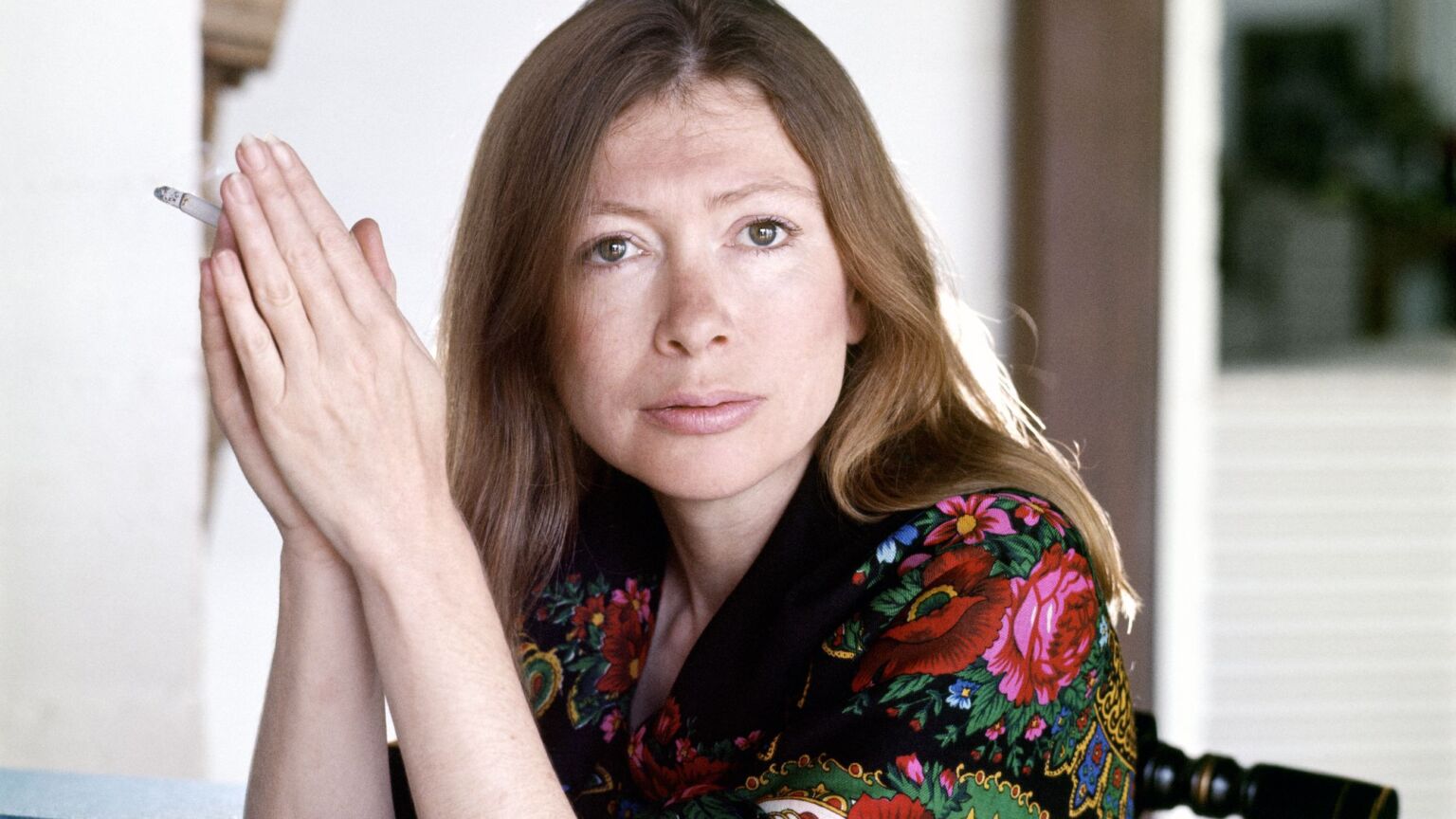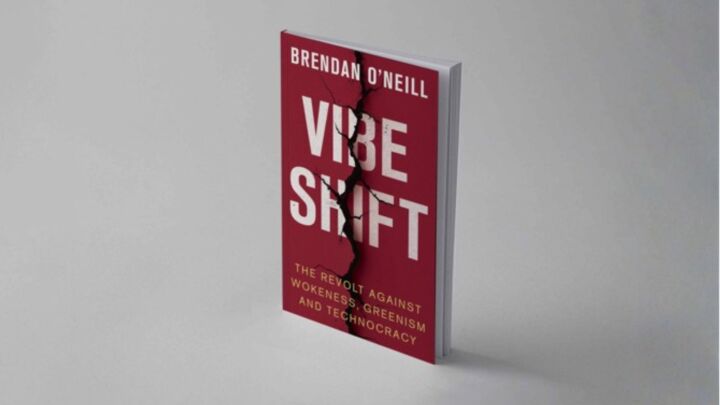The ice-cold brilliance of Joan Didion
She wrote with the style and the precision of a literary predator.

Want unlimited, ad-free access? Become a spiked supporter.
In the 2017 documentary, Joan Didion: The Centre Will Not Hold, Didion, the subject of the film, gives a telling response to a question from director Griffin Dunne, her nephew. She recounts scenes she and her husband, John Gregory Dunne, witnessed after they returned to her native California in 1964 from New York, where Didion had spent eight years writing for Vogue. The couple settled in a California vastly different from the Sacramento of Didion’s childhood. They were at the epicentre of a mutinous counterculture and, according to Didion, ‘participated in the paranoia of the time’. Housed in a ropey corner of Hollywood, they hosted parties that attracted the beautiful people, but remained too disciplined themselves to indulge in the excesses that took out many of the celebrities they entertained. Each morning Didion slipped on her sunglasses, sipped an ice cold Coke for breakfast, and started writing.
In Dunne’s documentary, she recalls a visit to the Haight-Ashbury neighbourhood in San Francisco, where she watched a five-year-old child, daubed in white lipstick, read a comic book while on acid. In response to the director asking her reaction, Didion replied: ‘It was gold.’ It’s a cold, dispassionate answer, but one in keeping with how Didion regarded her craft. Everything was there to be used, and as she once acknowledged, ‘writers are always selling somebody out’.
Does that also mean that writing should ultimately sell the writer out, when everything they committed to paper, that remained unpublished in their lifetime, is available posthumously? In 1998, Didion wrote of Ernest Hemingway that his wish was to be survived by only the words that he determined fit for publication. If this was also Didion’s wish, it’s not being adhered to.
In March this year, 336 boxes of her private papers, including menus and guest lists for those celebrated 1960s dinners she and her husband hosted, were made available at the New York Public Library. The release of these papers follows the publication in April of Notes to John, the unedited writings she committed to a notebook following her sessions with a psychiatrist from 1999. These were intended for her husband, who died four years later from a heart attack.
Back in Los Angeles, in the early days of their writing careers, Didion and Dunne were mining for gold while writing a column together along with Hollywood screenplays (including the 1976 adaptation of A Star Is Born). Mostly, Didion was writing alone, producing fiction and non-fiction essays in the elegant, chiselled style she honed at Vogue. The work was absorbed into the ‘new journalism’ canon, which included the dispatches of Tom Wolfe and Gay Talese. But Joan Didion was writing more personally, even when reporting on newsworthy events that were redefining American culture.
In the introduction to her 1968 essay collection, Slouching Towards Bethlehem, Didion recalls: ‘Whatever I do write reflects, sometimes gratuitously, how I feel.’ A decade later, taking her cue from the George Orwell essay ‘Why I Write’, for a lecture she delivered, she said: ‘In many ways writing is the act of saying I, of imposing oneself upon other people, of saying, “Listen to me, see it my way, change your mind”.’ Whether she was writing about John Wayne, the Black Panthers or the Manson family, Didion always returned to ‘the act of saying I’. This was evident from an early essay for Vogue entitled ‘On Self Respect’, in which she alludes to keeping a notebook, a habit that began in infancy and continued until her death.
Didion begins another book (The White Album from 1979) by informing us that we tell ourselves stories in order to live. She wrote to understand and articulate her own thoughts, and believed that, as a reporter, she was able to be an invisible witness. ‘I am so physically small’, she wrote, ‘so temperamentally unobtrusive, and so neurotically inarticulate that people tend to forget that my presence runs counter to their best interests’. This is certainly true when you compare her with Tom Wolfe, dressed like a southern American dandy from another era, and Gay Talese in immaculately tailored suits and pristine hats and spats. Yet the look that began to define her, the bobbed hair and oversized sunglasses, became her signature style. This is why fashion house Céline included her as a model in its ad campaign for spring 2015, six years before she died, aged 87.
Although many have been quick to canonise her, the odd dissident has emerged in the four years since her death, suggesting the Joan Didion persona was a conceit. This was reinforced last year, when a joint biography of Didion and fellow author Eve Babitz was published. The former was responsible for getting the latter a writing assignment at Rolling Stone. They were California girls. Didion was a descendant of prairie folk; Babitz a well-connected, wild-child party girl (infamous for being photographed naked while playing chess with Marcel Duchamp). Whereas Didion interviewed The Doors, Eve Babitz slept with them. According to the biography, the diminutive Didion used her evident brittleness to good effect, as it disguised the shrewd predator beneath: ‘It’s the tininess, it’s the sunglasses, it’s the shyness. But she’s a killer.’ Perhaps this was part of her appeal. Didion once wrote that our favourite people, like our favourite stories, become so because they illustrate ‘something deep in the grain, something unadmitted’.
Didion’s status as a national treasure was confirmed when Barack Obama presented her with the prestigious National Humanities Medal in 2012. Now, she had the venerable stature of those veteran writers revered as wise, sage-like elders of a tribe, with white New York liberals at their feet hanging on every syllable, as though each sentence is worthy of an award. Maya Angelou and Toni Morrison only needed to inform us that a bird in the hand was worth two in the bush to be in the running for the Pulitzer Prize. Didion belonged to this community of saints.
Despite her Californian origins, which she wrote about often, and was perhaps at her best and most brilliant when doing so, hers was very much a New York state of mind. In 1988, she returned to NYC and remained there until the end of her life. One of her most celebrated essays on her return was written for the New York Review of Books in 1991, in which Didion deftly addresses in detail the case of a 28-year-old female who was gang raped while jogging through Central Park in 1989. It was an unusual subject for the magazine’s readership and the demographic Didion was addressing. A gang rape in which the victim was white and the five perpetrators black and Hispanic was of little concern to the New York literati. But an essay that put history and the media on the stand over the case was gold. It was vindicated, too, when in 2002, the so-called Central Park Five were exonerated.
Here again, as with that child on LSD decades before, hers could be the dispassionate voice of the reporter. But that shifted when Didion made the subject herself, particularly when writing about loss. This was the underlying ache expressed in her 2003 memoir, Where I Was From:
‘I know what the fear is. The fear is not for what is lost. What is lost is already in the wall. What is lost is already behind the locked door. The fear is for what is still to be lost. There is no real way to deal with everything we lose.’
She deepened her reflections on grief with two further books that reached out to a wider readership. Firstly, The Year of Magical Thinking (2005), where she writes of her reaction to her husband’s death, while her daughter was in an induced coma. Secondly, Blue Nights published in 2011, six years after the death of her daughter, Quintana Roo Dunne, at 39. To Didion, as a wife and mother, these losses were devastating and tragic. To a writer like Didion, they too were gold.
In The Year of Magical Thinking, she notes:
‘We are imperfect mortal beings, aware of that mortality even as we push it away, failed by our very complication, so wired that when we mourn our losses we also mourn, for better or for worse, ourselves. As we were. As we are no longer. As we will one day not be at all. ’
As raw as these experiences were, in writing about them Didion remained in command of her subject, and the manner in which she approached it. But this was not so with the entries in her notebooks, which ‘could only mean something to the maker’, or indeed the husband to whom Notes to John is dedicated. This is apparent from the opening entry: ‘Re not taking (the antidepressant) Zoloft, I said it made me feel for about an hour after taking it that I’d lost my organising principle, rather like having a Planter’s Punch before lunch in the tropics.’
This, the last new book to carry Joan Didion’s name, is without the precision and style that defined the writing she put her name to. But it is perhaps more gratuitously about herself than all that went before.
Michael Collins is a writer, journalist and broadcaster. He is the author of The Likes Of Us: A Biography of the White Working Class.
You’ve read 3 free articles this month.
Support spiked and get unlimited access.
Help us hit our 1% target
spiked is funded by readers like you. It’s your generosity that keeps us fearless and independent.
Only 0.1% of our regular readers currently support spiked. If just 1% gave, we could grow our team – and step up the fight for free speech and democracy right when it matters most.
Join today from £5/month (£50/year) and get unlimited, ad-free access, bonus content, exclusive events and more – all while helping to keep spiked saying the unsayable.
Monthly support makes the biggest difference. Thank you.










Comments
Want to join the conversation?
Only spiked supporters and patrons, who donate regularly to us, can comment on our articles.